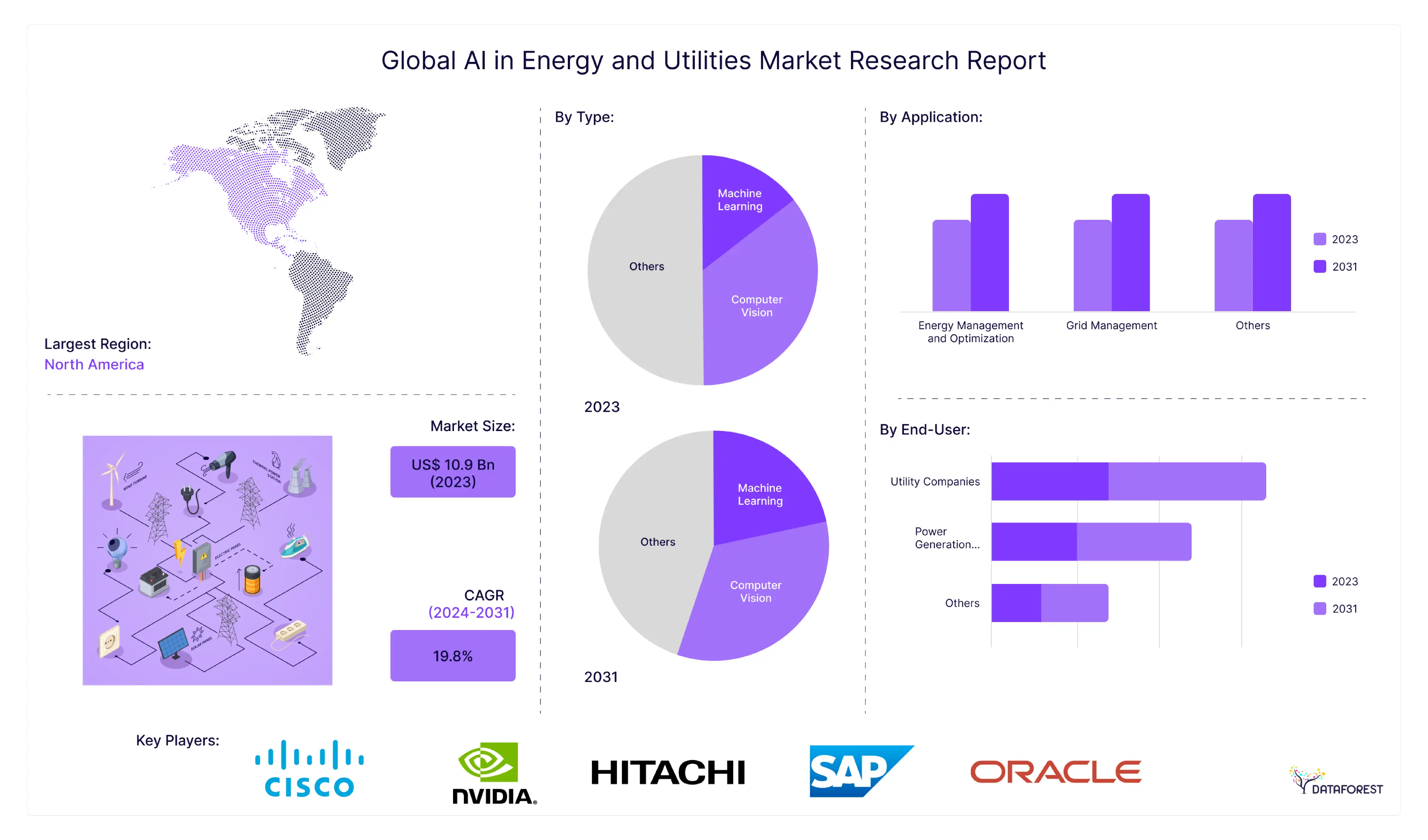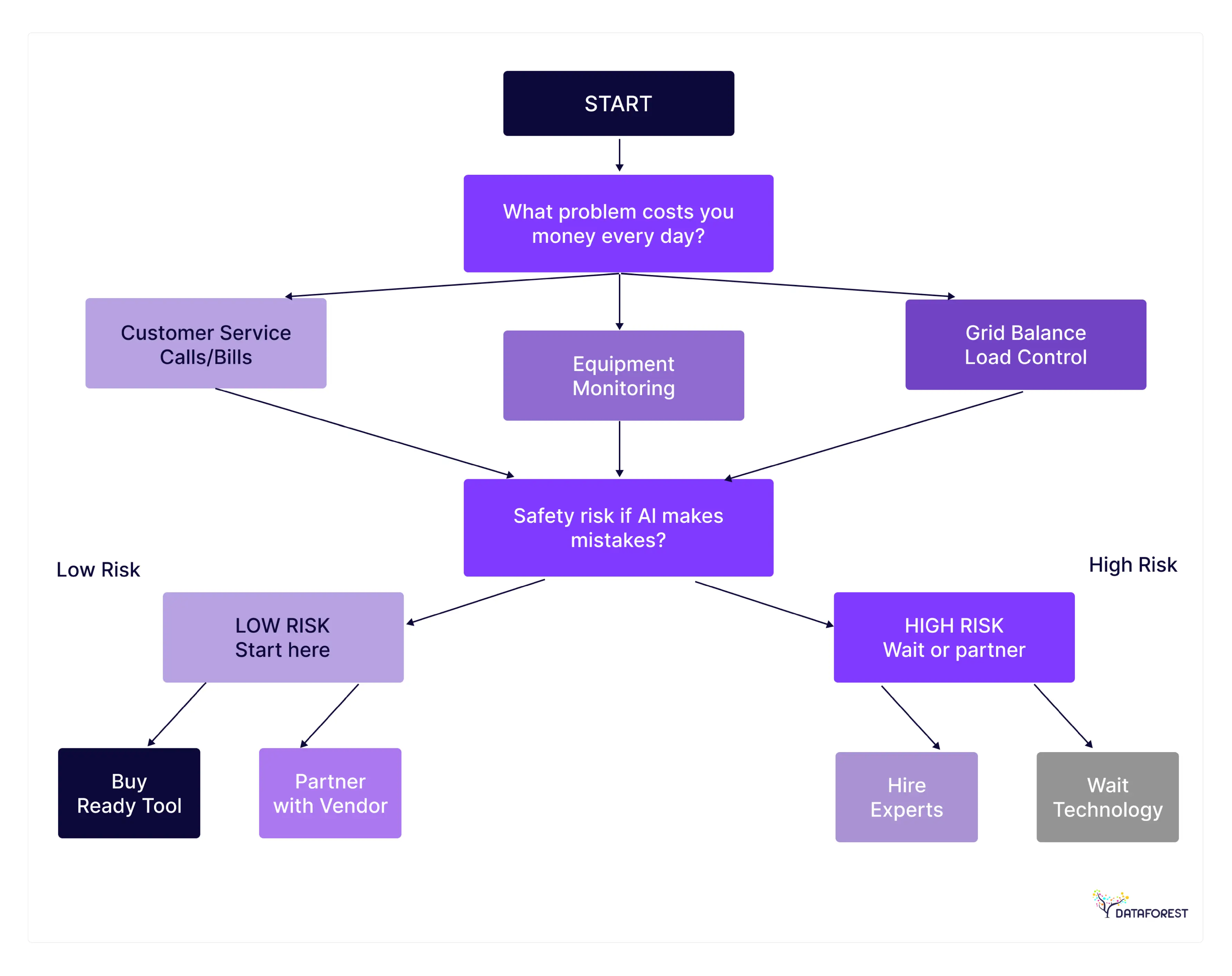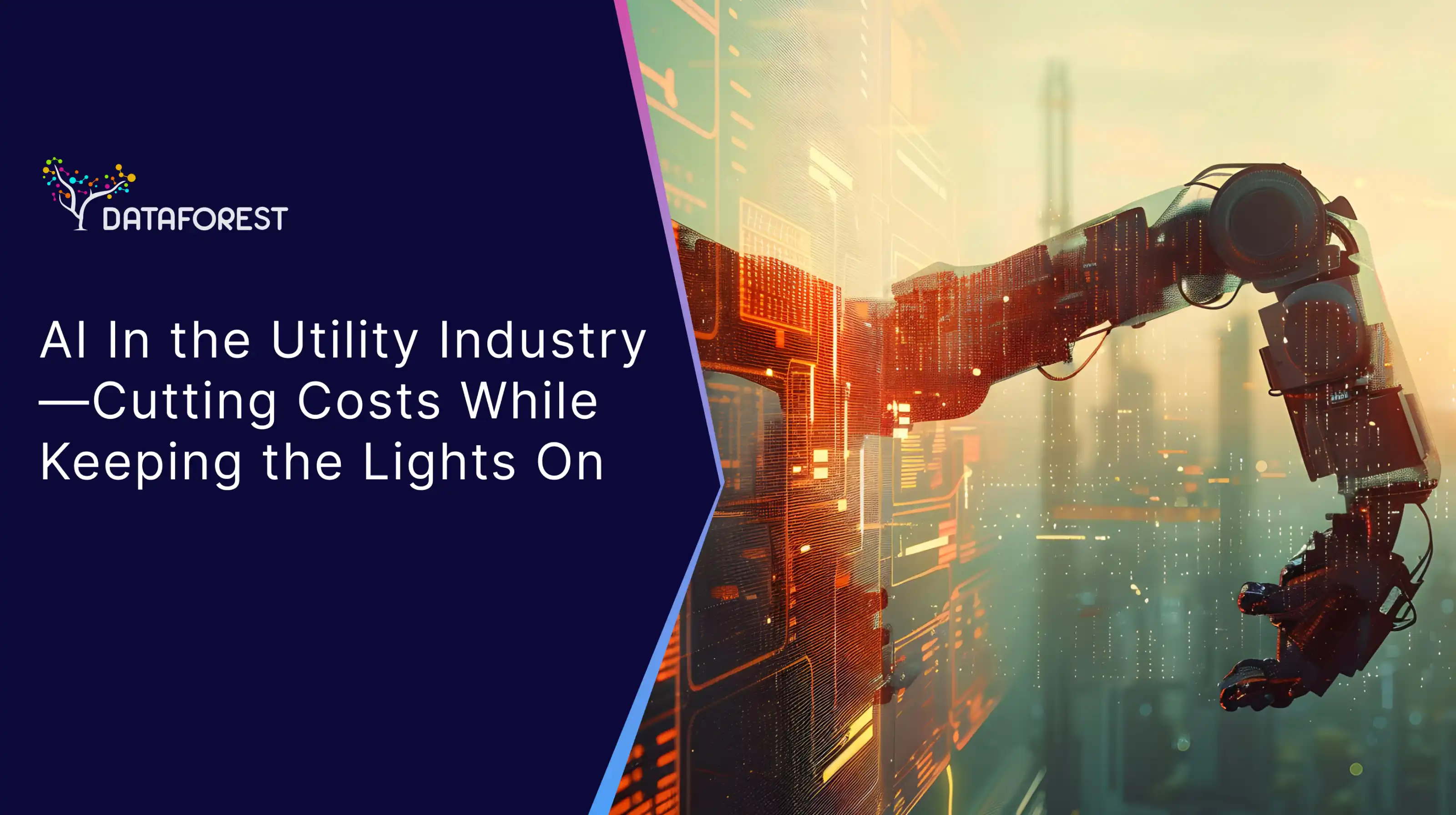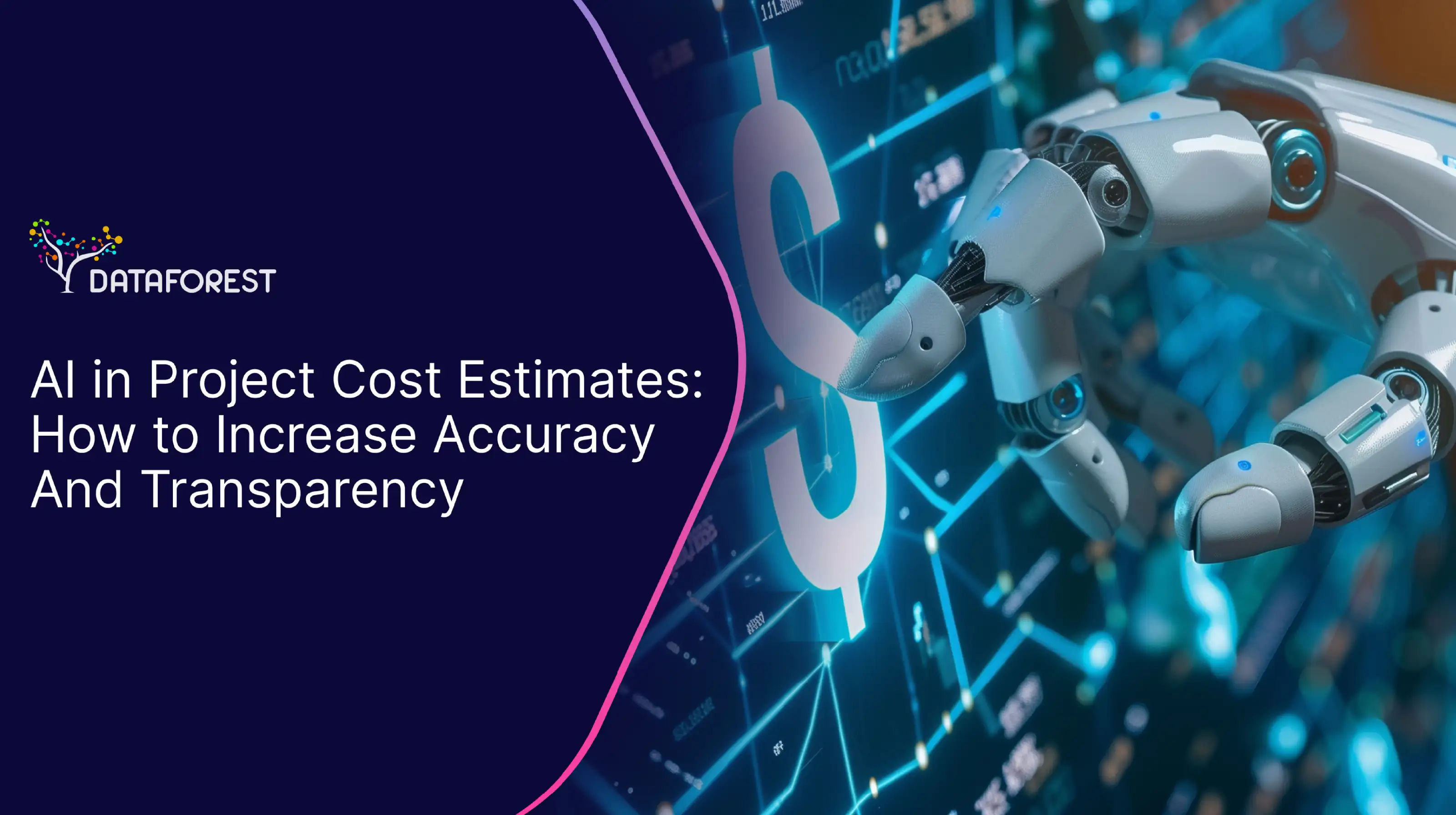A public utility in Alaska used AI agents to control microgrids during storms. They reduced diesel use by 40% and maintained power when roads were blocked. Another utility in Texas utilized AI to identify weaknesses in its aging infrastructure. It focused on repairs where storms hit hardest, cutting outage time by almost three-quarters. Select what you need and schedule a call.

Will AI Agents Save Your Utility Company or Just Create New Problems?
Medium notes that AI in utility industry agents offer reasoning, memory, and multi‑step workflows. This supports the use of cases such as predictive maintenance and asset coordination in infrastructure. Utilities are investing in AI agents and AI-powered customer service because other options are more expensive.
Moving Beyond Simple Automation
Your current automation handles one task at a time. Turn off this valve when pressure hits X. Send this email when payment is late. These are if-then rules dressed up as innovative technology.
AI-driven outage management agents make decisions across multiple systems simultaneously. They see a weather pattern, predict demand spikes, and adjust generation before your grid operators finish their coffee. They don't follow preset rules.
The difference matters when storms hit. Traditional automation shuts down equipment to prevent damage. AI in the utility industry agents keep power flowing by rerouting through backup systems you forgot existed.
But agents make mistakes humans wouldn't make. They optimize for metrics that miss the bigger picture. Your perfect efficiency numbers mean nothing when customers can't get anyone on the phone.
The technology works best when it handles routine decisions while humans manage exceptions.
Pressure From Every Direction
Regulators require grid modernization reports to be submitted on a quarterly basis. Environmental groups demand carbon reduction proof. Customers expect instant answers about outages caused by hitting utility poles.
You can't hire enough people to handle all these demands. Good utility workers are in high demand and difficult to find. The ones you have are busy keeping the lights on.
AI support handles the paperwork mountain. They generate compliance reports from sensor data. They track carbon emissions in real-time rather than relying on quarterly estimates. Customer service gets the biggest relief. Agents answer basic questions 24/7 without taking sick days or making vacation requests. Your human staff handles the complex problems that actually need human judgment.
The pressure doesn't go away. But you stop drowning in busy work that doesn't require expertise.
Getting Ahead Through Smart Operations
Your competitors are either already using AI in the utility industry or planning to start next year. Early adopters will have lower operational costs and better customer service scores.
AI in the utility industry agents spot equipment problems weeks before they become outages. They schedule maintenance based on actual wear patterns instead of calendar dates. They optimize energy purchasing based on real-time demand predictions.
The operational advantages compound over time. Better maintenance means fewer emergency repairs. Smarter purchasing means lower fuel costs. Faster customer service means higher satisfaction ratings.
But, the technology requires constant attention. Agents need training on new scenarios. They break when systems change. They make confident decisions based on incomplete data.
The companies that succeed will be those that use AI in the utility industry as tools, not replacements for human judgment.
Which AI Agent Use Cases Work in Utilities Right Now?
Most companies waste money on AI in utility industry projects that sound impressive but don't solve real problems. Here are the ones that actually cut costs and prevent disasters.
Catching Equipment Before It Breaks
Your transformers and turbines generate thousands of data points every minute. AI in the utility industry agents identify patterns that predict failures weeks in advance. This beats sending crews to check equipment on arbitrary schedules.
Balancing Power Without Human Guesswork
Smart grids have too many variables for humans to optimize manually. AI in utility industry agents adjusts power flow in real-time based on demand, weather, and equipment status. They prevent blackouts by moving electricity around faster than your dispatchers can think.
Stopping People Who Steal Power
Energy theft costs utilities billions annually. AI in the utility industry agents detect unusual consumption patterns that indicate illegal connections or meter tampering. They flag suspicious accounts for investigation instead of relying on field crews to stumble across problems.
Handling Customer Calls That Drain Resources
Most customer service calls are about the same five problems. AI in utility industry agents answer these questions instantly without putting people on hold. Human agents focus on complex issues that require problem-solving skills.
Making Renewable Energy Less Chaotic
Solar and wind power fluctuate unpredictably. AI in the utility industry agents forecast generation and adjust storage systems to smooth out supply variations. They help prevent grid instability when clouds block solar panels, or wind stops blowing.
Getting Workers Where They're Needed
Field service scheduling becomes impossible when you have hundreds of technicians and thousands of service requests. AI in the utility industry agents optimize routes and match worker skills to job requirements. They reduce truck rolls and improve first-time fix rates.
How Do You Pick AI That Won't Waste Your Money?
Utilities blow their AI budget on projects that sound smart but solve nothing. The successful ones start small and expand what works. Here's how to avoid expensive mistakes.
Pick Easy Wins First
Find problems that cost you money every day but don't affect safety. Customer service calls are about bill inquiries. Routine equipment inspections find nothing wrong. These are ideal for AI testing in the utility industry. AI agents handle these tasks without risking blackouts or regulatory fines. You achieve measurable savings within months, not years. Success here builds support for bigger projects later. Start with one use case and make it work perfectly. Then, move to the next problem.
Connect AI to What You Already Have
Your existing systems contain the data that AI agents in the utility industry need. Don't build new infrastructure when you can connect to current databases and sensors. This saves time and reduces integration headaches. Most utilities have adequate data collection but terrible data organization. Clean up your data flows before adding AI complexity. Otherwise, agents will make decisions based on incorrect or incomplete information. Legacy systems often resist modern connections. Budget for middleware that facilitates the translation between old and new technologies. Your 20-year-old SCADA system won't talk to cloud-based AI without help.
Choose Your Development Path
Building AI solutions from scratch in the utility industry can take years and cost millions. Most utilities lack the talent and time for custom development. Buying ready-made solutions allows you to get up and running faster, but it limits customization options. Partnerships with AI vendors offer a middle ground. They handle the technical complexity while you focus on utility operations. But you depend on their priorities and timeline for improvements. Evaluate your internal capabilities honestly. If you struggle with basic IT projects, custom AI in the utility industry development is likely to fail. Buy proven solutions and customize them gradually.
Get Your Data House in Order
AI in the utility industry requires clean, consistent data to make informed decisions. Your databases may contain duplicate records, missing values, and conflicting formats. Fix these problems before deploying AI. Data governance determines which systems can share information and who has control over access to that information. Establish clear rules about data ownership and security. Otherwise, AI projects stall in committee meetings due to permissions issues. Most utilities underestimate data preparation time. Plan for six months of cleanup work before AI in the utility industry agents produce valuable results. This may not be glamorous, but it's essential.
Book a call, get advice from DATAFOREST, and move in the right direction.

What's Really Stopping Your Utility from Using AI Agents?
Everyone talks about the benefits of AI adoption, but nobody mentions the real obstacles that can kill projects.
Keeping Hackers Out of Your Grid
Real-time monitoring for utilities can improve efficiency, but the cybersecurity team will hate AI in utility industry agents because they create new attack surfaces. Every connection between AI systems and operational technology provides hackers with another entry point. But you can't avoid utility sector digital transformation because competitors are already moving.
Start with AI agents that handle non-critical data, such as billing inquiries. Keep them completely separate from grid control systems. Add security controls gradually as you learn what works for you.
Getting Workers to Stop Fighting the Technology
Your experienced operators think AI will replace them or make their jobs meaningless. They're not wrong about job changes, but they're wrong about replacement. Smart utilities retrain people for higher-value work instead of laying them off.
Show workers how AI in the utility industry handles the tasks they dislike anyway. Let them focus on complex problems that require human judgment and expertise. The operators who embrace AI become more valuable, not less.
Proving AI Pays for Itself
Your board wants concrete numbers, not vague promises of efficiency. Calculate current costs for tasks that AI in utility industry agents will handle. Track time savings and error reduction in pilot projects to optimize efficiency. Build business cases with real data rather than relying on vendor marketing claims.
Start with problems that incur a measurable monthly cost. Customer service calls cost $15 each. Manual meter readings cost $25 per truck roll. These numbers make ROI calculations believable and straightforward.
Where Will AI in Utility Industry Agents Take Your Utility in the Next Five Years?
The technology will continue to improve, whether you use it or not. Your competitors are making bets on what comes next. Some will win big; others will waste millions on features that don't work. Scalable AI solutions for utilities that operate autonomously, with autonomous agents handling power routing, equipment switching, and outage response without human intervention, are likely to become more prevalent.
Grids That Run Themselves
- Most utilities aspire to achieve fully autonomous grid operations. AI in utility industry agents would handle power routing, equipment switching, and outage response without human intervention. This sounds perfect until you consider what happens when the AI makes a catastrophic mistake.
- The technology exists today for limited autonomous operations. AI in the utility industry can balance loads and reroute power during normal conditions. But, extreme weather, cyberattacks, and equipment failures create scenarios no training data covers.
- Regulatory approval will take years. Utilities that kill people lose their licenses. No regulator wants to approve systems that could cause blackouts across entire regions.
- Smart utilities will deploy autonomous AI in utility industry agents for non-critical decisions first. Let AI handle routine switching during periods of low demand. Maintain human control during storms, peak loads, and emergency situations.
Workforce optimization means retraining existing employees to adapt to new technologies rather than seeing them as a threat. Predictive maintenance in utilities and data-driven utility operations will increasingly become the standard as the industry moves toward full automation and AI-driven solutions.
Environmental Compliance Without Armies of People
Sustainability reporting currently requires teams of analysts collecting data from dozens of systems. AI in utility industry agents could generate these reports automatically from sensor data and operational records. This eliminates human error and reduces compliance costs.
The regulatory landscape changes constantly. New carbon tracking requirements appear every year. AI in utility industry agents adapts to new reporting standards faster than human teams can retrain. But garbage data creates garbage reports. Your current systems don't track emissions consistently across all operations. AI agents will quickly expose these data quality problems.
Environmental groups and regulators will scrutinize AI-generated reports more carefully than human-created ones. They won't trust automated compliance without extensive audit trails. Your AI in the utility industry had better be able to explain its calculations.
Multiple AI Systems Working Together
Today's AI in utility industry agents work in isolation. Future systems will coordinate across multiple utilities, vendors, and service providers. Your maintenance AI could share equipment data with your supplier's inventory AI to optimize parts delivery and maintenance. This collaboration has the potential to revolutionize the way utilities operate. Shared weather data improves demand forecasting. Coordinated maintenance schedules to reduce equipment costs. Regional grid optimization prevents cascading failures.
The technical challenges are massive. Different utilities use incompatible systems. Data formats vary between vendors. Security requirements prevent easy information sharing.
Legal and competitive issues create bigger obstacles than technical ones. Utilities typically do not share operational data with competitors. Antitrust regulations limit coordination between companies. Privacy laws restrict the sharing of data across state lines.
The utilities that figure out selective collaboration will have significant advantages. But most will struggle with the complexity for years.
How DATAFOREST Handles AI Agent Adoption in Utilities
DATAFOREST starts by auditing existing systems and data flows to ensure clean, reliable inputs for AI agents. We design custom AI agents for the utility industry that learn from your utility's specific processes, equipment, and terminology. Our platform integrates with SCADA, asset management, and control systems via secure, enterprise-grade APIs. The team leverages automated scaling, monitoring, and audit logs to meet compliance and uptime requirements. We deploy early pilots—like outage prediction or pump optimization—and tune agents based on real performance data. If pilots show value, engineers scale them up through modular, workflow‑centric rollouts instead of big-bang AI implementations. Throughout, we emphasize governance, explainability, and ongoing support to make sure agents stay reliable and trusted long-term. Please complete the form to begin using AI agents in utilities.
FAQ On AI In the Utility Industry
Is it necessary to have a fully digital infrastructure before implementing AI agents?
No, but your data needs to be accessible in some way. Most utilities have sufficient sensors and databases to initiate simple AI projects. You'll hit walls quickly if your systems can't talk to each other.
Can AI agents be integrated with legacy SCADA or ERP systems?
Yes, but it's expensive and messy. You'll need middleware to translate between old and new systems. Expect six months of integration work for every legacy system you connect.
What kind of data do AI agents require to function effectively?
Clean, consistent data with precise timestamps and units. Your current data has gaps, duplicates, and format inconsistencies. Plan to spend more time cleaning data than building AI.
Are there ready-to-use AI agent platforms tailored for the utility sector?
Several vendors offer utility-specific AI agent platforms. They handle common problems, such as outage management and demand forecasting. Custom solutions still require months of configuration and testing.
What are the main risks or limitations when using AI agents in mission-critical operations?
AI agents make confident decisions based on incomplete information. They can't handle situations for which they weren't trained. One wrong decision during a storm could cause region-wide blackouts.
Can AI agents operate autonomously, or do they require constant human oversight?
AI agents can run independently for routine tasks. But, someone needs to monitor their decisions and intervene when things go wrong. Full autonomy works for billing questions, not grid control.
How is artificial intelligence transforming the utility industry?
Companies are leveraging artificial intelligence in utilities for energy consumption optimization, ensuring efficient distribution and reduced wastage. This transformation leads to cost reduction through the use of AI, while also enhancing service reliability for customers.
What role do AI agents play in improving customer experience for utility companies?
AI agents are driving customer service automation, enabling utility companies to handle queries and service requests more quickly and efficiently. By integrating AI agents in utilities, they automate billing support, outage notifications, and personalized energy usage recommendations.







.svg)
.webp)















